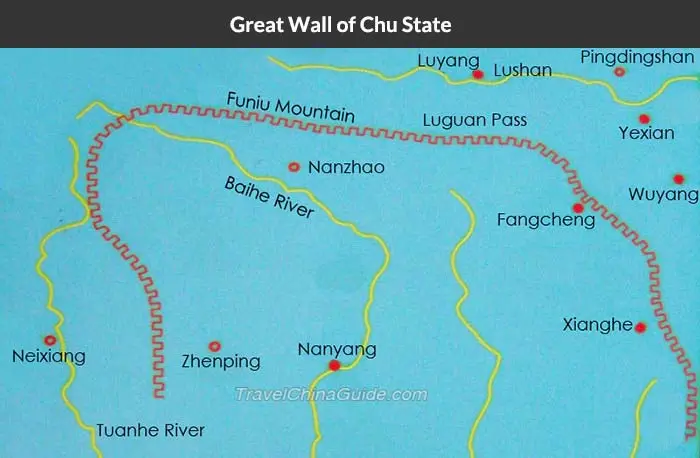Great Wall of Chu State
The Chu State was one of the powerful states of the turbulent Spring and Autumn Period (770BC-276BC) of the Zhou Dynasty. Inspired by fortifications of Prehistoric Times (1.7 million years ago- the 21st century BC), this defensive wall was constructed to shore up its territory and defend against attacks from other states.
Facts of the Chu State Great Wall
![]() The whole defensive system resembles a "∩" shape, almost forming a square, hence the name "Square Wall". Its total length is 310 miles (500 kilometers).
The whole defensive system resembles a "∩" shape, almost forming a square, hence the name "Square Wall". Its total length is 310 miles (500 kilometers).
![]() The main constructions are passes instead of wall. There were more than 700 pass cities at once, which varied in size according to the number of soldiers and the rank of the military officials. The large pass cities, like Zhoujiazhai, are located on the essential roads, while smaller ones are located at the precipitous and secret spots. The pass cities are square in shape. Ancient people believed that the heaven is round and the earth is square. So the buildings are mostly square.
The main constructions are passes instead of wall. There were more than 700 pass cities at once, which varied in size according to the number of soldiers and the rank of the military officials. The large pass cities, like Zhoujiazhai, are located on the essential roads, while smaller ones are located at the precipitous and secret spots. The pass cities are square in shape. Ancient people believed that the heaven is round and the earth is square. So the buildings are mostly square.
![]() At inaccessible high mountains and torrential rivers, no wall or pass was built, in order to save construction materials. Mountains and rivers were used as natural barriers. The dangerous terrain and the solid human construction worked together, forming a defensive line.
At inaccessible high mountains and torrential rivers, no wall or pass was built, in order to save construction materials. Mountains and rivers were used as natural barriers. The dangerous terrain and the solid human construction worked together, forming a defensive line.
![]() Construction materials were acquired locally. As the wall mainly crawls across the Funiu Mountain, most of the wall was built with stones. In areas without abundant stones, earth or a combination of earth and stones were used.
Construction materials were acquired locally. As the wall mainly crawls across the Funiu Mountain, most of the wall was built with stones. In areas without abundant stones, earth or a combination of earth and stones were used.
 |
| Chu State Great Wall Map |
∩-Shaped Great Wall
Relics of the Chu State Great Wall
Urgent Protection is Needed
The Great Wall of the Chu State is seen as an invaluable treasure by experts and archeologists, but to locals, it is only a wall made of rammed earth or stones. In summer, it is engulfed by exuberant woods and weeds. In winter, locals build fires to keep warm at the foot of the wall. The wall also suffers from other human activities. Locals bring the wasteland under cultivation after tearing down the wall, and they dig holes at the foot of the wall in search of scorpions, a kind of Chinese medicine. What's worse, mining, building roads, houses, and power stations pose a great threat to this time-honored heritage. Additionally, natural erosion is an important factor. Storms, earthquakes, and lightning strikes are speeding up the wall's disappearance.
Fortunately, the locals in Nanzhao County have recognized the importance of this wall, and have started to protect it. They have ascended the mountain ridges and gathered a lot of information about the relics. Nevertheless, the protection of this widely-distributed heritage needs personnel and financial support from the government. Let's act now to protect it before it is gone forever.![]() See more
See more
Top 8 Great Wall of China Events in History
Zhou Dynasty Great Wall: